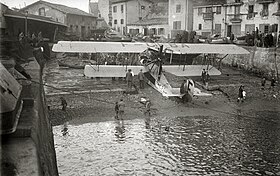avia.wikisort.org - Avion
Le Lévy-Le Pen HB2 (désignation constructeur : Georges Lévy G.L. 40) était un hydravion à coque militaire, conçu par l'ingénieur Maurice Jules-Marie Le Pen (1889-1919) au sein de la société Hydravions Georges Lévy.
|
Lévy-Le Pen HB2
| |
 Lévy-Le Pen HB2 de la Compagnie Franco-Bilbaine de Transports Aériens dans le port de San Sebastián, Espagne | |
| Constructeur | |
|---|---|
| Statut | Retiré du service |
| Mise en service | |
| Date de retrait | |
| Équipage | |
| 2 | |
| Motorisation | |
| Moteur | Renault 12Fe |
| Nombre | 1 |
| Type | moteur V12 |
| Puissance unitaire | 224 kW (300 ch) |
| Dimensions | |
| Envergure | 18,50 m |
| Longueur | 12,40 m |
| Hauteur | 3,85 m |
| Surface alaire | 68,75 m2 |
| Masses | |
| À vide | 1 450 kg |
| Maximale | 2 350 kg |
| Performances | |
| Vitesse de croisière | 115 km/h |
| Vitesse maximale | 145 km/h |
| Plafond | 3 500 m |
| Rayon d'action | 400 km |
| Armement | |
| Interne | 200 kg de bombes |
| Externe | 1 mitrailleuse |
| modifier |
|
Conception
Notes et références
Bibliographie
- (en) Stéphane Nicolaou, Flying Boats & Seaplanes : A History from 1905, MBI Publishing, , 191 p. (ISBN 0-7603-0621-4, EAN 978-0-76030-621-5, lire en ligne).
- Daniel Parrochia, L'homme volant : philosophie de l'aéronautique et des techniques de navigation, Seyssel, Editions Champ Vallon, , 317 p. (ISBN 2-87673-367-6, EAN 978-2-87673-367-1, lire en ligne), p. 132.
- Pierre Gaillard, Aéronautique navale de chez nous, MDM, 144 p. (ISBN 978-2-402-10516-3 et 2-402-10516-X, EAN 978-2-40210-516-3, lire en ligne).
Liens externes
- Gérard Hartmann, « Les hydravions Georges Lévy », sur La Coupe Schneider et hydravions anciens. Dossiers historiques hydravions et moteurs (consulté le ).
- Portail de l’aéronautique
- Portail du monde maritime
- Portail de la France
- Portail de la Première Guerre mondiale
- Portail de l’Armée française
На других языках
[en] Georges Levy G.L.40
Georges Levy G.L. 40 HB2 was a three-seated French, amphibious biplane aircraft that was designed in 1917. The aircraft was designed by Blanchard and Le Pen and therefore the aircraft was also known as the Levy-Le Pen. Le Pen was Maurice Jules-Marie Le Pen born in Lorient, Morbihan, France in 1889; he was killed in a car crash in 1919. It was claimed to be the best French amphibious aircraft of World War I, but that is probably due to the low scale production of such aircraft in France at that time.[1]- [fr] Lévy-Le Pen HB2
[it] Lévy-Le Pen HB2
Il Lévy-Le Pen HB2 (conosciuto anche come Georges Lévy G.L.40) fu un idrovolante biplano da ricognizione marittima sviluppato dall'azienda aeronautica francese Hydravions Georges Lévy di Argenteuil nella seconda metà anni dieci del XX secolo e prodotto in grande serie.[2]Текст в блоке "Читать" взят с сайта "Википедия" и доступен по лицензии Creative Commons Attribution-ShareAlike; в отдельных случаях могут действовать дополнительные условия.
Другой контент может иметь иную лицензию. Перед использованием материалов сайта WikiSort.org внимательно изучите правила лицензирования конкретных элементов наполнения сайта.
Другой контент может иметь иную лицензию. Перед использованием материалов сайта WikiSort.org внимательно изучите правила лицензирования конкретных элементов наполнения сайта.
2019-2025
WikiSort.org - проект по пересортировке и дополнению контента Википедии
WikiSort.org - проект по пересортировке и дополнению контента Википедии